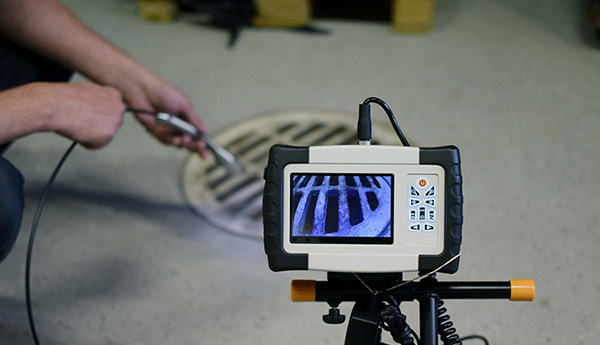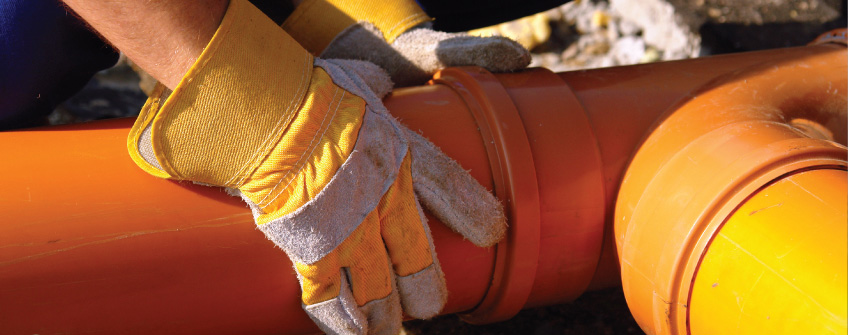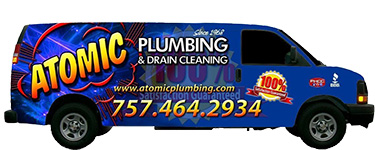How to Identity and Fix a Sewer Line Clog: A Guide for Homeowners
Plumbing isn’t the most pleasant dinner conversation topic. Nevertheless, it’s a topic everyone who lives in a home should have a basic understanding of, especially when it comes to clogs in a sewer pipe. Beyond the inconvenience factor, sewer line clogs, if ignored, can cause health issues. To help you avoid messy, stinky, unpleasant plumbing problems, we’ve put together a guide to sewer drain clogs. This article covers what causes clogs, how to know you have a clog, how to prevent sewer backups, and how a professional plumber can help manage this critical plumbing problem.
Why So Much Concern Over a Clogged Sewer Line?
To understand why a sewer line causes so much excitement, you’ll want to understand the basics of home plumbing system design. Residential plumbing systems have one big job: delivery and removal. The system delivers fresh water into your home via pipes and water supply lines. The supply lines send the clean water to the various fixtures and water-using appliances.
You create wastewater when you flush a toilet, wash the dishes, or run your washing machine. When the plumbing system works correctly, it removes the wastewater, eventually draining it into your main sewer pipe. The main sewer pipe, or line, connects the whole plumbing system.
If you could look at a schematic of a residential plumbing system, you would see the main sewer line with a series of pipes branching off and connecting to the drains throughout your house.
A clog in the sewer line means the wastewater coming from those drains has nowhere to go.
It’s not as mysterious as it seems, and when you understand how it all works together, you also understand why sewer lines concern most homeowners. Since they’re buried underground, sometimes as deep as six feet, you don’t know what’s going on with them until you have a problem.
What Are the Signs of a Sewer Line Clog?
While there are some obvious signs you have a sewer line clog (like sewage backing up through your drains), it’s not always easy to determine what’s going on deep in your plumbing system.
Sometimes homeowners mistake a clog in the sewer line for a clogged drain. Sure, blocked drains cause problems, but they’re usually easier to fix with a plunger or drain cleaner.
Here are a few common clues that you have a clog in your sewer line:
- Toilet gurgles
- Multiple slow-running drains
- Foul drain odors
Two Signs You Have a Clogged Sewer Line
When troubleshooting sewer line problems, you have two items in your home that can nearly guarantee evidence of a clog in your sewer line. The toilet and your washing machine.
Toilet backups
When you experience persistent toilet clogs, despite taking care not to flush unsuitable items, that’s evidence that the actual problem is likely farther downstream in your sewer system. You can plunge all day, but the clog will keep coming back.
Water from the washing machine
Now, this is a confusing occurrence for almost anyone (unless they’re a professional plumber), but it’s a good sign of a sewer line clog. Modern plumbing design ensures you can shower, flush toilets, and run a washing machine — all at once. You should never see water coming up through the shower drain when you’re washing clothes. If that happens, it warrants further inspection, preferably by your local plumbing contractor.
What Causes a Sewer Line Clog?
A home or business plumbing system turns on a relatively simple design. A residential system can manage approximately 300 gallons per day, with 72 gallons used for flushing toilets.
Should it surprise anyone that this busy system sometimes doesn’t behave itself? Sewer line clogs happen for a variety of reasons. Some are manmade, while others are due to forces beyond a homeowner’s control. Here are the reasons you may develop a clog in your main sewer line:
Damaged sewer pipes
Time isn’t a friend to sewer pipes. Over time, sediment can build up, and corrosion can deteriorate the pipe’s interior, creating cracks and leaks. Natural soil movement can cause sewer lines to sag. Sagging sewer lines make your system more susceptible to repeat clogs, leaks, and breakage.
Using the Toilet as a Trash Can
Talk to your favorite plumber and ask what interesting items they’ve found when troubleshooting a toilet. You might be shocked! The truth is most of us are guilty of misusing our toilets. However, there are only two things that should go down a toilet drain:
- Human waste
- Toilet paper
Unfortunately, people do mistake the toilet as a one-stop-shop for getting rid of some household items, including:
- Diapers
- Baby wipes
- Personal cleansing wipes
- Feminine products
- Paper towels
- Napkins
- Pills
- Food
Plumbers have found dinosaur toys, jewelry, and teeth in sewer pipes. People sometimes flush (or attempt to flush) food down the toilet, which is a horrible idea. Even if that chicken carcass ends up going down the toilet drain, it could eventually rest in the main sewer line, where it attracts other solid waste. Some of that solid waste is a combination of fats, oils, and grease — known in the plumbing world as FOG. It’s a recipe for a sewer line clog and a common reason for calling a plumber.
Can Tree Roots Damage Sewer Lines?
Yes, we said the previous section would cover all causes of sewer pipe clogs. There’s one more, and it may or may not be directly caused by you. While most problems with sewer lines originate inside the plumbing system, tree roots are one of the most common outside contributors to damaged sewer lines.
Trees can only grow and live a healthy life if they have plenty of water and nutrients. Your plumbing pipes offer the perfect menu: oxygen, nutrients, and water. Warm water flowing in the sewer line creates a vapor. When the vapor releases into the soil surrounding the sewer pipes, it’s like a siren call to tree roots. Tree roots find loose joints or cracks in the sewer pipe and force themselves in to feed on the nutrient-rich wastewater. Once they’re in, the roots continue growing, all the while causing bigger cracks. If ignored long enough, tree roots can destroy a sewer pipe.
How Can You Be Sure You Have a Problem with Tree Roots?
Tree root intrusion is one of the most common causes of clogged or damaged sewer lines. But without being able to visualize the inside of your sewer pipes, how do you know it’s tree roots and not something else creating the problem? Calling a plumbing professional who can perform a camera inspection is the only way to be sure about what is going on in the pipes. If you’re curious about how a camera inspection works, here is the process: The plumbing technician locates the cleanout. The technician inserts an internal pipe inspection camera attached to a long, flexible cable into the cleanout. The technician then feeds the camera down into the sewer line. Attached to the cable is a small fiber-optic camera. The camera connects to a closed-circuit display.
Lights on the camera allow the technician to view the interior of the sewer pipe.
The technician can then see everything in the pipe, including tree roots.
Even if there are no tree roots present, a camera inspection also identifies other reasons for sewer drain clogs. The camera reveals debris, hair, foreign objects, and even the tiniest cracks in the sewer line.
Can You Prevent Tree Roots from Taking Over a Sewer Pipe?
You can avoid expensive sewer line damage and messy sewage backup cleanup by taking a few preventative measures. Remember earlier when we mentioned tree roots are natural? We also noted that tree root damage in your sewer line may or may not be your fault. Here are a few helpful things you can do to prevent tree root intrusion:
Plant sewer-safe trees
Maybe you’re not the original owner of your home and had no part in planting the trees in your yard. You can be smart about what you grow close to your sewer lines in the future. If you want trees in the area near your sewer line, plant slow-growing trees with less aggressive roots. Also, take care to plant trees as far from the sewer line as possible. A minimum distance of 10 feet is recommended.
Create a barrier
There are several barriers homeowners can use to prevent tree roots from invading sewer lines. Ask a plumbing professional about slow-release chemicals (potassium hydroxide or copper sulfate). Spreading these chemicals near your sewer line helps prevent tree root growth. Another preventative measure is to bury metal or wood barriers 6 to 12 inches deeper than the sewer pipe. These barriers run vertically and do an excellent job of stopping tree root intrusion.
Once roots have taken hold in a sewer pipe, you’ll likely need to call a plumber for tree root removal services.
How Should You Prevent a Sewer Line Clog?
While there’s not much you can do about an aging plumbing system; there are other steps you can take to prevent sewer line blockages, including:
- No FOG down the drain
- Put all food waste in the trash
- Keep hair out of bathroom drains, including tubs and showers
- Add bacteria to your drains
- Avoid flushing anything other than human waste and toilet paper
You can also prevent sewer line clogs by scheduling annual inspections and cleanings.
Can You Fix a Clogged Sewer Line Without Professional Help?

As soon as you tell a few friends or relatives you have a sewer line backup, you’ll be on the receiving end of all kinds of advice. Some of it may be helpful, but much of the advice people offer about clearing sewer blockages are anecdotal. Sure, you can try pouring a vinegar mixture and water down the drain. Or pour boiling water down the drain. You could even try the old bent wire hanger method.
These and other home remedies may unclog a floor drain or one of the other drains in your home, but they rarely resolve a clog in your main sewer pipe. When home remedies don’t work, it means you can’t reach the clog as it’s much deeper in the system. Main sewer line blockages need the help of a professional plumber. Plumbers use a range of methods to blast through sewer line clogs. In some cases, a clog is so severe it takes hydro-jetting the pipes in your plumbing system to clear it.
Is Fixing a Sewer Line Expensive for a Residential Location?
Any savvy homeowner wants to know how much they can expect to spend on home repairs. Cost is one of the reasons some homeowners avoid dealing with plumbing problems in the first place. It’s easier to ignore what’s right under your feet (or your house) until you have a plumbing emergency, right? The concern over expense is understandable, especially with the ever-growing costs to repair just about anything in your home. Repairs to sewer lines aren’t the most expensive plumbing repair, but they’re also not the cheapest. For example, calling a plumber to fix a clogged drain or toilet costs an average of $225. Sewer line repair can cost between $2,000 – $2,500, with additional charges associated with driveway repair (if the plumber needs to cut into it to access sewer pipes) and lawn repair.
Do Sewer Lines Need to Be Replaced Over Time?
Like other major systems in your home, sewer lines have a useful service life. When they get to the end of it, you’ll need to consider whether repair or replacement is the best solution.
Several factors come into play when determining if you need to replace a sewer line. One is age, but other determiners include how well you’ve maintained the plumbing system, whether you have tree root intrusion, and whether you’re dealing with a burst pipe. Since you’ll likely need to call a plumber to help figure out your plumbing issue(s), they can steer you in the direction that best suits your needs and the condition of the existing sewer line.
Need Help With a Clogged Sewer Pipe?
Now that you better understand your plumbing system and issues that impact sewer line clogs, you’re better prepared to deal with any current or future problems. If you have a clogged sewer pipe, it’s best to call a plumber as soon as possible. Those clogs won’t dissolve on their own, and the longer you ignore them, the bigger the clog can grow. The plumbing professionals at Atomic Plumbing have been in the business since 1968. We’re happy to come out and help get your sewer line unclogged or take care of any other plumbing needs. Contact us today for a service quote.



